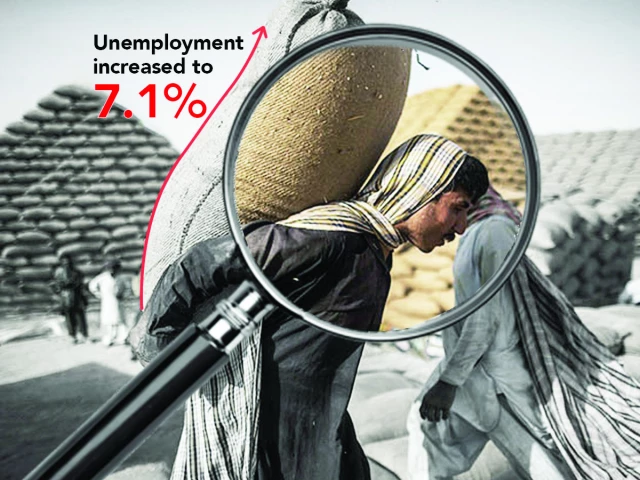ISLAMABAD:
The new Labour Force Survey has revealed that the unemployment rate in Pakistan rose to the highest level in 21 years at 7.1% in the last fiscal year, which Minister for Planning Ahsan Iqbal said was the result of the International Monetary Fund (IMF) programme and climate-induced disasters.
The government on Tuesday unveiled the Labour Force Survey, which showed that the highest unemployment was in Khyber-Pakhtunkhwa (K-P), followed by Punjab. The lowest unemployment was in Sindh. The findings showed that the unemployment rate, which was 6.3% in 2021, went up to 7.1% during fiscal year 2024-25, said Dr Naeemuz Zafar, Chief Statistician of the Pakistan Bureau of Statistics (PBS), while sharing the main findings of the survey.
Official records showed that 7.1% was the highest unemployment rate since 2003-04, when the ratio had been recorded at 7.7%. Since then, unemployment has remained in the range of 5.3% to 6.9%. In 2018-19, the unemployment rate was 6.9%.
The unemployment rate increased due to climate disasters and the IMF’s stabilisation programme, which constrained economic growth, said Ahsan Iqbal, while speaking on the occasion. He said that the global price cycle also impacted the employment status.
The PML-N government signed a three-year, $7 billion IMF programme in September last year and agreed to implement around 50 conditions.
Out of the nearly 180 million working-age population, around 118 million, or two out of every three persons, were unpaid employees doing services at homes like cleaning, fetching water, taking care of children and raising chickens.
Nearly one-fourth of the unpaid workers were engaged in household jobs, 18.7% were engaged in livestock, 23% were taking care of children, 7% were fetching water for home, and 7.1% were engaged in raising chickens at home.
Former prime minister Imran Khan had said that people could earn good money by breeding hens and selling their eggs. The survey revealed that over 7% of the working-age people were doing this business, which helped restrict the overall unemployment rate to a single digit in the first year of the Shehbaz Sharif government.
Out of the total 5.9 million unemployed people, 4.6 million, or 77.5%, were literate. Nearly one million people with educational degrees were unemployed. The highest number of unemployed people was in the age group of 15 to 29 years, followed by the age group of 15 to 24 years.
The survey showed that the highest unemployment rate of 9.6% was in K-P, followed by 7.3% in Punjab, 5.5% in Balochistan and 5.3% in Sindh. Pakistan’s average economic growth remained less than 3% for a long time, and the economy was not creating enough jobs to absorb new entrants. Every year, 3.5 million people enter the job market.
The planning minister said that the trend was shifting from agriculture to services, and as a result, the employment share in the agriculture sector went down in the last fiscal year. The increase in the number of people looking for jobs was more than the employment opportunities created by the economy, according to the survey.
The agriculture sector’s share in total employment decreased by 4% to 33.1%. The manufacturing sector’s share also marginally went down to 14.4%, underscoring the challenges industries face due to the double-digit interest rate, high energy costs and exorbitant taxes.
Wholesale and retail trade share in employment increased to 16% of total employment.
Successive governments were reluctant to hold the Labour Force Survey, but the current administration had to do it as part of the conditions agreed with the IMF. It is the second report in the past few days that Pakistan has released as part of the IMF conditions after publishing the Governance and Corruption Diagnostic Assessment.
The chief statistician said that the government released the livestock census and the Labour Force Survey as part of IMF conditions, while the Household Integrated Economic Survey would be released next month. The survey findings are based on a sample size of 54,832 households. The labour force participation rate, which is expressed as the labour force, employed plus unemployed, as a percentage of the 10-plus population, increased from 44.9% to 46.3%. Survey results indicated that the labour force increased from 71.8 million in 2020-21 to 83.1 million in 2024-25. This shows that 3.5 million per annum are added to the labour force, according to the chief statistician.
Employees constitute the largest group of 43.5%, followed by own account workers at 36.1%, contributing family workers at 19.1% and employers at 1.3%. Almost one-half of female workers toil as contributing family workers, and almost one-half of males are working as employees.
The share of employment in the informal sector is more than 72% of non-agricultural employment, with a higher share in rural areas than in urban areas. In contrast, formal sector activities are more concentrated in urban areas. The report showed that at the national level, the average monthly wage of paid employees increased significantly between 2020-21 and 2024-25, rising from Rs24,028 to Rs39,042.
The average monthly wage of males increased from Rs24,643 to Rs39,302 and that of females from Rs20,117 to Rs37,347. Ahsan Iqbal said that the wage gap between male and female workers had reduced by almost half during the survey period. The report disclosed that a significant proportion of respondents were engaged in domestic and care work, with 45.4 million women involved in household chores, 32.1 million in livestock operations and 20 million in caregiving responsibilities, highlighting their vital roles in these areas.

